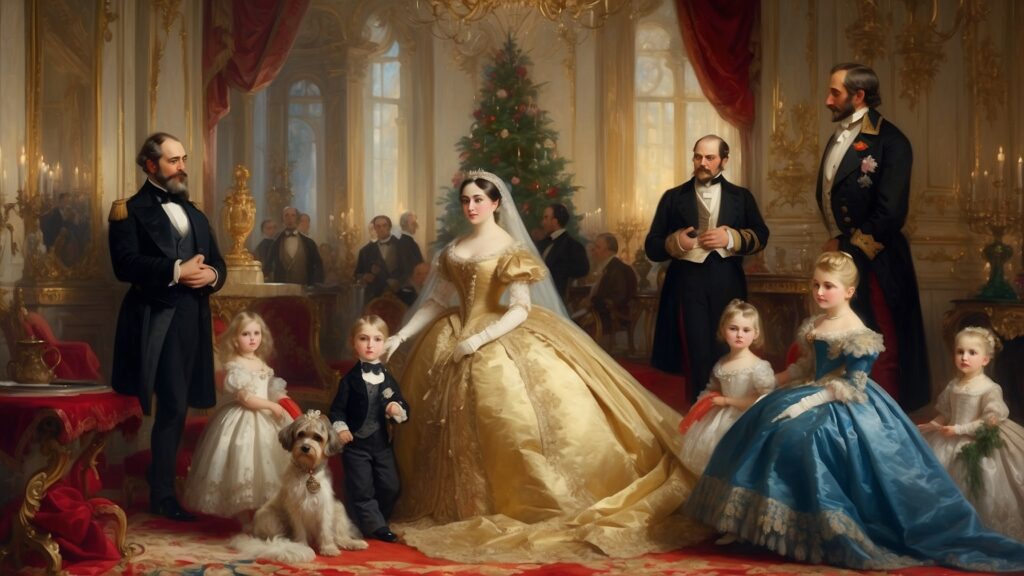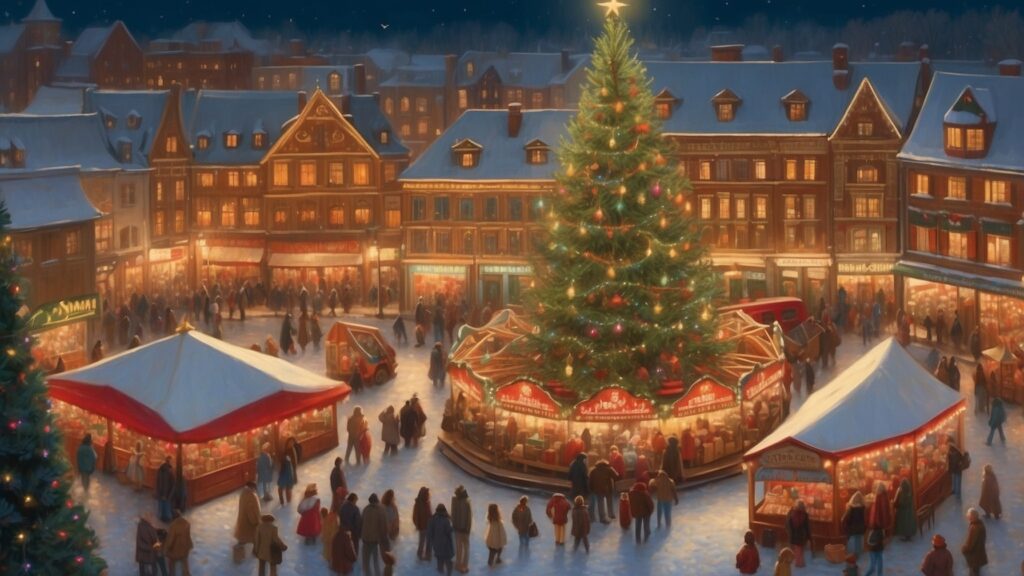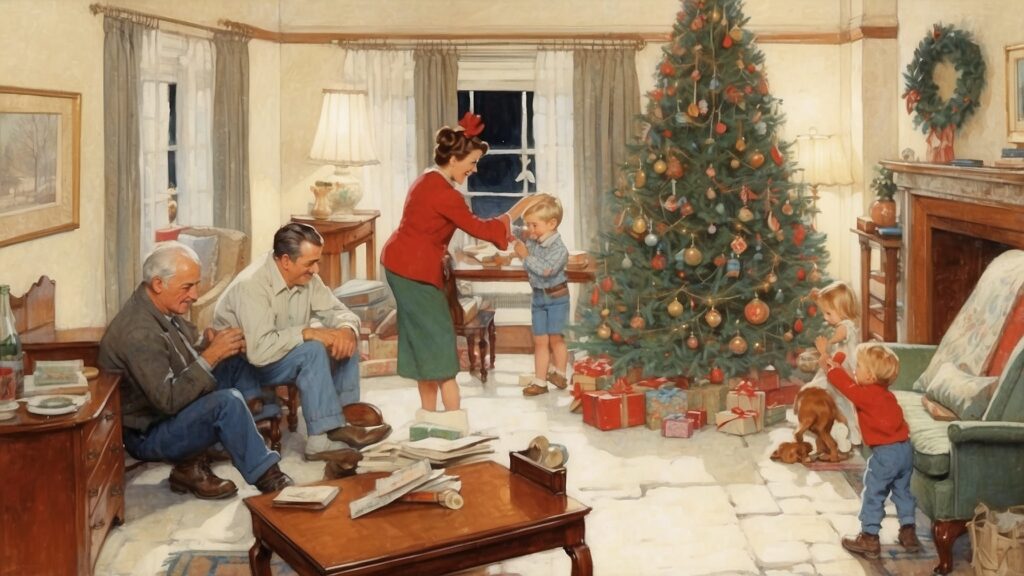Evolution of the Christmas Tree: A Journey Through Tradition and Innovation
The Christmas tree has a long and fascinating history.
Starting from ancient pagan traditions to the modern-day, this symbol has evolved dramatically over the centuries.
Today, Christmas trees are adorned with LED lights, color-changing styles, and synchronized music.

Originally, Christmas trees were part of pagan winter festivals.
They were later adopted and adapted by Christians as they spread across Europe.
This tradition gained massive popularity during the Victorian era when Queen Victoria’s German husband, Prince Albert, put one up in their home, making it fashionable for many families.
Modern Christmas trees have become symbols of joy and togetherness, with endless variations and styles.
From minimalist designs to intricate replica kugel ornaments, these trees reflect cultural diversity and personal creativity.
Table of Contents
- 1 Find the Best Accommodations
- 2 The Ancient Pagan Traditions
- 3 The Christianization of Pagan Practices
- 4 The Renaissance and the Spread of Christmas Trees in Europe
- 5 The Victorian Era and the Popularization in England
- 6 Arrival in North America
- 7 The Modern-Day Christmas Tree
- 8 Cultural Variations Around the World
- 9 Symbolism and Meaning in Contemporary Celebrations
- 10 Frequently Asked Questions
- 10.1 What is the origin of the Christmas tree tradition?
- 10.2 How has the Christmas tree’s design changed since the 1980s?
- 10.3 What does the Christmas tree represent in a spiritual context?
- 10.4 Who is credited with starting the tradition of the Christmas tree?
- 10.5 Why do people decorate Christmas trees?
- 10.6 What are the historical developments in the Christmas tree’s evolution?
Find the Best Accommodations
Visitors like you rated these hotels, guesthouses and apartments as ‘superb’ or ‘exceptional’. No reservation fees.
Key Takeaways
- The Christmas tree evolved from ancient pagan traditions to modern times.
- Popularized during the Victorian era, it became a household fixture.
- Today’s trees showcase cultural variations and modern technology.
The Ancient Pagan Traditions

Discover how centuries-old pagan customs have shaped the Christmas tree tradition, through the lens of tree worship, early winter solstice celebrations, and the use of evergreen trees.
Origin of Tree Worship
Tree worship dates back to ancient times when various cultures revered trees as sacred beings.
For instance, the ancient Egyptians believed in the symbolic power of evergreens, associating them with eternal life.
Druids, the priestly class in ancient Celtic cultures, held oak trees in high regard.
They often performed rituals in oak groves, believing these trees to possess special powers.
Trees were more than just plants; they were believed to house spirits and gods.
Their towering presence provided a bridge between the heavens and the earth, making them central to spiritual practices.
Early Winter Solstice Celebrations
The winter solstice, occurring around December 21 in the Northern Hemisphere, marked an important time of the year for ancient cultures.
It signaled the shortest day and longest night, a pivotal moment for renewal and rebirth.
Saturnalia, a Roman festival honoring the god Saturn, was one such celebration.
During this time, homes were adorned with greenery, and people exchanged gifts. This period of festivity and goodwill laid the groundwork for many modern Christmas customs.
Many northern European traditions, including those of the ancient Germans, also centered around the solstice.
Celebrating the return of longer days, they engaged in various rituals and feasts to honor the sun and its life-giving energy.
The Use of Evergreen Trees
Evergreen trees played a significant role in these ancient traditions.
They were valued for their ability to remain green throughout the harshest winters, symbolizing endurance and resilience.
In Germanic folklore, after Saint Boniface felled a sacred oak dedicated to the Norse god Thor, legend says an evergreen tree sprouted in its place.
This event symbolized a shift from pagan practices to Christian ones, intertwining the old and new traditions.
Evergreens like fir, pine, and holly were commonly used in winter solstice celebrations.
Their lush green needles provided a sense of hope and life even during the darkest time of the year. This practice eventually evolved into the modern tradition of the Christmas tree.
Explore the fascinating origins of what now stands as one of the most beloved symbols of the holiday season.
The Christianization of Pagan Practices
The history of the Christmas tree involves the transformation of pagan rituals into a Christian tradition.
Early Christians adopted numerous elements from these older customs, infused them with Christian symbolism, and spread them through influential figures like St. Boniface.
Adoption by Early Christians
Early Christians incorporated several pagan customs into their own practices to make the new religion more familiar.
Winter solstice celebrations, such as the Roman Saturnalia and the Germanic Yule, featured decorations and feasts. By aligning Christmas with these festivals, Christians found it easier to convert pagan followers.
The use of trees and greenery was common in these solstice practices.
By bringing these elements into Christmas, the early Church created a blend of traditions that appealed to converts.
This fusion helped the new customs gain acceptance and become widely practiced.
Symbolism in Christian Tradition
The Christmas tree’s shift from a pagan symbol to a Christian one involved reinterpreting its meaning.
Christians saw the evergreen tree as a representation of eternal life, inspired by the Paradise tree from medieval plays that depicted the Garden of Eden.
The tree’s triangular shape also symbolized the Holy Trinity for many believers.
Decorating the tree with lights and ornaments added layers of meaning.
Candles represented Christ as the light of the world, while ornaments often featured religious symbols or scenes.
This transformation allowed the tree to serve as a visual representation of Christian beliefs and stories, enriching the tradition.
Influence of St. Boniface
St. Boniface played a crucial role in the Christianization of the Christmas tree.
In the 8th century, he traveled to Germany to convert pagan tribes. According to legend, he encountered people worshipping an oak tree dedicated to the Norse god Thor.
To demonstrate the power of Christianity, he cut down the oak and pointed to a nearby fir tree, proclaiming it a symbol of Christ.
This story highlights the efforts of missionaries to replace pagan symbols with Christian ones.
St. Boniface’s actions not only spread Christianity but also helped embed the Christmas tree into Christian tradition. His influence is a key factor in the tree’s transformation from a pagan icon to a beloved part of Christmas celebrations.
The Renaissance and the Spread of Christmas Trees in Europe
The Renaissance played a key role in the integration and popularity of Christmas trees in Europe. This period highlighted the significance of these festive symbols, starting in Germany and later spreading to other parts of the continent.
The First Christmas Trees in Germany
During the 16th century, Germany was the birthplace of the modern Christmas tree.
People began to bring evergreen trees into their homes and decorate them with various ornaments.
These trees became more than just decorations; they symbolized hope and renewal during the harsh winter months. Evergreen trees holding their leaves throughout the year represented endurance and life.
Some families used candles, fruits, and sweets to embellish their trees. These decorations brought a warm, festive atmosphere to their homes.
The tradition quickly gained traction, becoming a beloved cultural practice in Germany.
This new way of celebrating the winter season was soon adopted by other German communities, adding distinct regional touches to the custom.
Role of Martin Luther
Martin Luther, a key figure during the Renaissance, is often credited with popularizing the Christmas tree.
Legend has it that Luther was inspired by a night walk through a forest filled with twinkling stars above evergreens.
Wanting to share this experience with his family, he brought a tree into his home and decorated it with candles.
This created an enchanting effect, symbolizing the light of Jesus Christ.
Luther’s influence helped the Christmas tree become a significant part of holiday celebrations in Protestant households.
His action transformed a simple practice into a widespread tradition across Northern Europe.
As more people began to adopt Luther’s idea, the decorated tree turned into a central element of Christmas festivities.
Spread to Other European Countries
The tradition quickly moved beyond Germany, reaching other parts of Europe.
The Christmas tree became especially popular in royal courts.
For example, Queen Victoria and Prince Albert of Britain embraced the practice in the 19th century.
Their Christmas tree at Windsor Castle became iconic after it was featured in an illustration in the London News.
This royal endorsement sparked widespread adoption across the British Isles and beyond.
Soon, many European families, regardless of social status, had Christmas trees of their own.
The practice became rooted in various Christmas customs throughout Europe, symbolizing unity, joy, and the festive spirit of the season.
You can read more about the history of Christmas trees and their spread in Europe during the Renaissance.
The Victorian Era and the Popularization in England
The Christmas tree became a staple in English holiday celebrations during the Victorian era. This era saw Prince Albert introduce the tree and Queen Victoria help it gain widespread popularity. Victorian decorations added unique touches.

Introduction by Prince Albert
Prince Albert, the German-born husband of Queen Victoria, introduced the Christmas tree to England.
In 1841, he set up the first known Christmas tree at Windsor Castle. The tree was adorned with traditional German decorations like wax candles, fruits, and sweets.
This display captured the public’s imagination. The tree was a hit, transforming from a royal novelty to a household tradition.
Families all over England began to emulate the royal tree, cementing the practice in British culture.
Influence of Queen Victoria
Queen Victoria’s influence played a major role in popularizing the Christmas tree in England.
Her personal endorsement of the tree, noted in her journals and public appearances, made it fashionable.
The Illustrated London News published a drawing of the royal family gathered around a decorated tree in 1848, showcasing the domestic bliss of the royal family.
This image became iconic, encouraging more families to adopt the Christmas tree tradition.
Victoria also emphasized the tree’s role in family bonding and festive joy. This royal stamp of approval made the Christmas tree an essential part of the holiday.
Victorian Christmas Tree Traditions
Victorian decorations transformed the Christmas tree into a festive focal point.
Trees were adorned with homemade ornaments, including thread-covered nuts, paper flowers, and small gifts.
Glass ornaments, imported from Germany, became popular as well.
Illuminating the tree with candles added a warm glow. Families also draped the tree with garlands of popcorn or cranberries.
Christmas crackers, invented in 1847 by Tom Smith, added a new element of surprise to the holiday.
These crackers, with their small explosive “crack,” became a hit and were often used as tree decorations.
Arrival in North America
The Christmas tree tradition came to North America through German immigrants and quickly became popular. From individual homes to public displays, the Christmas tree tradition grew in the United States during the 19th century.

German Immigrant Influence
German immigrants are largely responsible for bringing the Christmas tree tradition to North America.
By the 1830s, they started putting up Christmas trees in their homes. This practice was already common in Germany since the 16th century.
In Pennsylvania, where many German settlers lived, Christmas trees became a familiar sight.
The practice spread quickly. Community trees were even set up in towns, reflecting the growing enthusiasm for this festive tradition.
The influence of German immigrants on Christmas celebrations in North America cannot be overstated. They played a key role in making the Christmas tree a central part of holiday decorations.
Early American Christmas Trees
In American homes, early Christmas trees were often decorated with handmade ornaments.
These ornaments included fruits, nuts, and paper flowers.
Candles were used to light up the trees, adding to the magic of the holiday season.
In 1846, the trend received a big boost when an illustration showed Queen Victoria and Prince Albert with their decorated tree.
This image was widely shared in the United States, making the Christmas tree even more fashionable.
Soon, American households across many states began to embrace the tradition.
Adoption Across the United States

The Christmas tree became widely adopted across the United States by the late 19th century. In 1882, the first tree was lit by electricity in New York, marking a significant advancement. Edward Johnson, an associate of Thomas Edison, used 80 small bulbs to decorate the tree.
This innovation led to the commercial production of electric Christmas lights by 1890.
Public displays and community trees also became more common. Cities and towns across the country began to set up large, decorated trees in public spaces. The Christmas tree had officially become a beloved and enduring symbol of the holiday season in America.
By the turn of the century, the Christmas tree was firmly entrenched in American culture. The efforts of German immigrants and advances like electric lights helped to make it a widespread tradition.
The Modern-Day Christmas Tree
Modern Christmas trees have evolved with trends in decoration, changes in production, and a focus on environmental impact. Here, we’ll explore commercialization, evolving decoration trends, and sustainable practices.
Commercialization and Mass Production
The rise of commercialization has transformed Christmas trees into a massive industry. Stores are filled with various types of trees from late November onward.
Artificial trees play a significant role, providing a reusable and hassle-free option.
Injection-molded tips and pre-lit features have made artificial trees very popular. They come in many shapes, sizes, and even colors. The mass production process allows for consistent quality and availability, meeting the high demand each season.
By making trees more accessible, commercialization has ensured that nearly every household can celebrate the holidays with a Christmas tree.
Trends in Decoration
Trends in Christmas tree decorations change each year, influenced by social media, home décor trends, and personal taste.
Some people prefer a minimalist look with simple ornaments, while others go for extravagant, themed decorations.
Popular themes include traditional red and green, rustic farmhouse styles, and even pop culture references like specific movie themes or fandoms.
LED lights have become a staple for modern decorations due to their energy efficiency and variety of colors.
Personalized ornaments and DIY projects also play a big role, allowing people to create unique, custom-decorated trees.
The Environmental Impact and Sustainable Practices
With growing concerns about climate change, sustainable practices around Christmas trees are becoming more popular.
Artificial trees, while reusable, have a carbon footprint tied to their production. On the other hand, real trees are renewable but require careful cultivation and transportation.
Some solutions include renting live trees that can be replanted after the holiday season. Others prefer trees made from recycled materials or those certified as sustainably grown.
These practices help reduce environmental impact while still enjoying the festive spirit.
Choosing eco-friendly decorations, like LED lights and natural ornaments, can further align your Christmas tree with sustainable practices.
Cultural Variations Around the World
Different countries celebrate Christmas with unique traditions. From the festive joy of Europe to North American customs and unique practices elsewhere, each place brings its local customs to the holiday.
European Traditions
In Europe, Christmas traditions vary widely. One well-known tradition is from Germany, where people first started using Christmas trees in the 16th century.
Another example is Norway and Sweden, where Christmas involves singing carols and decorating trees with handmade ornaments.

In the Netherlands, there’s the story of Sinterklaas, who brings gifts to children on December 5. In parts of Europe, like Austria, people recognize Krampus, a figure who punishes bad children. Christmas also includes large family meals and midnight church services.
North American Customs
In North America, specifically the United States and Canada, Christmas trees are a central part of the celebration.
Families typically decorate them with lights, baubles, and tinsel. You might see outdoor decorations, like lights on houses and lawn ornaments.
Gift-giving is a major component, often taking place on Christmas morning. Santa Claus, who has roots in European folklore, is a beloved figure. Children believe he comes down the chimney to deliver presents. Special meals often feature turkey or ham, along with various side dishes and desserts.
Unique Practices in Other Countries
Other parts of the world have their own unique practices.
In Japan, Christmas is not a national holiday, but people often celebrate with certain foods like fried chicken and cakes due to clever marketing by companies like KFC.
In Russia, the New Year’s tree is used instead of a Christmas tree, highlighting the New Year celebrations more than Christmas itself.
In the southern hemisphere, like in Australia, Christmas falls in the summer, so activities might include barbecues and trips to the beach. Decorations still include trees and lights, even in sunny, warm weather.
Symbolism and Meaning in Contemporary Celebrations
The Christmas tree holds deep meaning for many people today. It represents life, family traditions, and has both religious and secular significance in today’s society.
The Christmas Tree as a Symbol of Life
The Christmas tree stands as a powerful symbol of life. Evergreens, which keep their needles all year, remind us of nature’s persistence and the cycle of life.
These trees were used in winter festivals long before Christmas became a holiday. They are seen as a beacon of hope during the dark days of winter.
The lights and ornaments you hang represent stars, snowflakes, and sometimes even stories of growth and rebirth. Each decoration adds depth to this living symbol.
Family and Tradition

Family and tradition play a significant role in how the Christmas tree is celebrated.
Many families have unique tree-decorating traditions that are passed down through generations. From choosing the perfect tree to placing the star on top, these moments create lasting memories.
The act of decorating the tree together brings families closer, fostering a sense of unity and togetherness. This ritual can turn a simple tree into a symbol of family bonds and shared values.
Religious and Secular Significance
The Christmas tree has both religious and secular significance.
For many Christians, the tree symbolizes the “Light of the World,” representing Jesus Christ. The star often placed on top symbolizes the Star of Bethlehem, which led the Wise Men to Jesus.
But the tree also holds meaning for those who don’t celebrate Christmas religiously.
It’s a festive way to brighten up homes and bring warmth in winter. Whether lit with candles or electric lights, it brings people together, making the holiday season special for everyone.
You can learn more about the rich history and symbolism of Christmas trees here.
Frequently Asked Questions
In this section, you’ll find answers to common questions about the origins, evolution, and traditions of the Christmas tree, and its significance both culturally and spiritually.
What is the origin of the Christmas tree tradition?
The Christmas tree tradition started in Germany in the 16th century. Devout Christians brought decorated trees into their homes. Some built Christmas pyramids of wood and decorated them with evergreens and candles.
How has the Christmas tree’s design changed since the 1980s?
Since the 1980s, artificial trees have become more popular.
They come in various colors and styles, from classic green to bold white or even pink. Pre-lit trees save time on stringing lights, and collapsible designs make storage easier.
What does the Christmas tree represent in a spiritual context?
The Christmas tree symbolizes eternal life in Christianity. The evergreen tree, which stays green throughout the winter, represents life and rebirth. It also recalls the Tree of Life from the Garden of Eden.
Who is credited with starting the tradition of the Christmas tree?
Martin Luther is often credited with starting the tradition. Legend says he was inspired by the stars shining through evergreen trees and brought a tree into his home, decorating it with candles to mimic the starlight.
Why do people decorate Christmas trees?
People decorate Christmas trees to celebrate the joy and spirit of Christmas.
Decorations like ornaments, tinsel, and lights add a festive touch to homes and bring families together in a cherished tradition.
What are the historical developments in the Christmas tree’s evolution?
In the 19th century, Christmas trees became popular in the United States and England. They were decorated with apples, nuts, and marzipan cookies.
By the late 19th century, glass ornaments from Germany were common.
Electric lights became popular in the early 20th century. They replaced candles and made trees safer.
Christmas Market Closures
Due to econonic conditions and tariffs, some Christmas Markets may cancel their events due to lack of vendors. If you are aware of a closed market,or find errors on a listing or an image, please reach out on our Contact Us page so that we may update this post.




